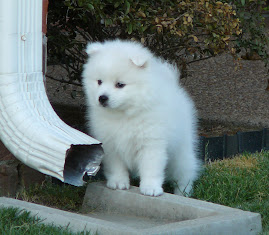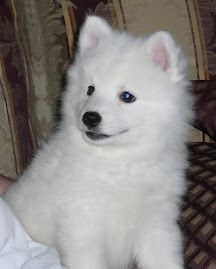When little Ju-Ju was about six months old, she absolutely hated walking on a leash. She can be a stubborn little thing. The more we tugged on her leash, the more she would pull back. Eventually, she would just plop down and refuse to go any further. To combat this problem, we taught her how to loose-leash walk.
Japanese Spitz respond very well to praise and positive reinforcement, so with training a JS to do anything, be sure to use this method. When teaching very young or very stubborn puppies, you'll need to sweeten the deal a little by adding a very tasty treat to the mix. The treat should be something that you can cut into very small pieces (you'll be using a lot of them). I like to use bits of fat-free shredded cheese or small, diced pieces of a turkey hot dog. Don't use these treats for anything other than your training sessions because you'll want your puppy to stay excited about the possibility of getting to eat some of these treats.
Put these treats in a Ziploc bag & tie the bag to your belt loop or put it in your pocket. Make sure to put it on the same side of the body that your dog will be on. You'll need easy access to the treats, so leave the bag open. Now, that your prep work is done, slip a leash on the little guy let's get started.
First, stand beside your dog and hold the leash in your opposite hand. In other words, if your dog is on the right side of your body, hold the leash in your left hand. Now, using your right hand, show your dog the treat. Let him smell it, and then let him eat it. Do this just once. Now he knows what a good thing he's in for if he does what is asked of him.
Take another treat out of the bag and let him see it. Now, while holding the leash loosely with slack, say the words, "Lets go" and take a step or two forward, starting with the leg that is closest to your dog. Hopefully, he will walk with you, following the treat. If he does, give him the treat, pet him & praise him with lots of "Good boys!". If he doesn't follow, stop walking, bend down and and encourage him to come to you. When he does, give him the treat, petting and praise.
Repeat this process, slowly increasing the amount of steps you take between treats. Eventually, following beside you while on a leash will be common-nature to him.
Some important things to remember: (1) Begin your training session in an area your dog is familiar with, so there won't be any distractions. (2) Your dog may try to jump up on you to get the treat or for praise. If this happens, stop walking and correct him by firmly tell him "No". You don't want to encourage this behavior. Now, take a step forward. If he walks forward, give him the treat, petting & praise and resume the training session. (3) If your dog is young, he may get bored easily. Keep your training sessions short - no longer than 15 mins at a time, twice a day. (4) Always end your training sessions on a positive note.
Now, Ju-Ju loves her leash walks just as much as our other dogs. She even gets excited when she sees us pull her harness/leash out of the drawer because she knows a walk is in her immediate future. With a little patience, your dog will be just as eager to wear his leash and go on walks with you!
(A special thanks to little Shiro and his human companion, Simon, for suggesting this topic of discussion.)












